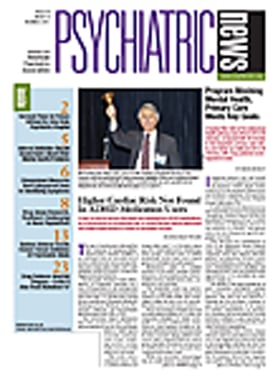Fatty Acids May Help Depression Recovery
Researchers at Leiden University in the Netherlands recently examined the effects of omega-3 fatty acid supplementation on cognition and mood of individuals who had recovered from depression.
In their study, 71 participants aged 18 to 65 who were recovering from a major depressive episode received either omega-3 (fish oil) or placebo (olive oil) supplements for four weeks in a randomized double-blind design.
Participants were evaluated for neutral and emotional information-processing tasks. Mood was self-reported, measured with the shortened Profile of Mood States. Depressive symptoms were measured with the Beck Depression Inventory-II, and cognitive reactivity was assessed with the Leiden Index of Depression Sensitivity– Revised.
Results showed small effects of omega-3 supplementation on aspects of emotional decision making and on self-reported states of depression and tension. No significant effects were observed on memory, attention, cognitive reactivity, and depressive symptoms.
“While inconclusive, the present findings may indicate that omega-3 supple mentation has selective effects on emotional cognition and mood in recovered depressed participants,” the researchers wrote.
Antypa N, Smelt A, Strengholt A, et al.: Effects of Omega-3 Fatty Acid Supplementation on Mood and Emotional Information Processing in Recovered Depressed Individuals. J Psychopharmacol. 2011. Oct 16 [Epub ahead of print]. <www.ncbi.nlm.nih.gov/pubmed/22004690> Rebound Insomnia, Withdrawal Not a Problem With Chronic Hypnotic Use
Researchers at the Sleep Disorders and Research Center of the Henry Ford Hospital in Detroit have published the results of their efforts to determine the likelihood of rebound insomnia and withdrawal symptoms associated with zolpidem, a nonbenzodiazepine hypnotic. Rebound insomnia was defined as worsened sleep relative to baseline when discontinuing a hypnotic, as opposed to withdrawal syndrome, which is considered the expression of a new symptom complex.
Thirty-three individuals aged 32 to 64 meeting DSM-IV-TR criteria for primary insomnia were enrolled in the prospective, double-blind, placebo-controlled study. The presence of rebound insomnia was assessed at months 1, 4, and 12 by substituting placebo for zolpidem for seven nights and collecting nocturnal polysomnographic reports on nights 1, 2, and 7. The presence of withdrawal symptoms on the first two placebo-substitution nights was assessed with the Tyrer Benzodiazepine Withdrawal Symptom Questionnaire.
Approximately 30 percent to 40 percent of participants did show rebound insomnia, but that percentage did not differ between the placebo and zolpidem groups and did not increase over 12 months. No clinically significant withdrawal symptoms were observed on the discontinuation nights over the 12 months of nightly use. This study was funded by the National Institute on Drug Abuse.
Roehrs T, Randall S, Harris E, et al.: Twelve Months of Nightly Zolpidem Does Not Lead to Rebound Insomnia or Withdrawal Symptoms: A Prospective Placebo-Controlled Study. J Psychopharmacol. 2011. Oct 16 [Epub ahead of print]. <www.ncbi.nlm.nih.gov/pubmed/22004689> Suicide Risk Rises in Older Adults With Schizophrenia
Older adults diagnosed with schizophrenia have an elevated mortality risk of suicide, according to researchers from the Mental Health Centre Copenhagen in Denmark and the Johns Hopkins School of Public Health in Baltimore. The group examined registry data on 2,899,411 men and women aged 50 or older living in Denmark during 1990-2006, correcting for sociodemographic and health-related differences.
Results indicated excess suicide mortality for older adults with schizophrenia, compared with other older adults, which declined with increasing age. Although similar results have been reported in men, “this has not been previously demonstrated for women,” wrote the researchers. “To our surprise, we find a relatively higher risk among women with schizophrenia measured relative to the general population than for their male counterparts. Identified predictors of risk for suicide were diagnosis of schizophrenia, greater number of hospitalizations, recent admission (for men), recent discharge, previous suicide attempt, recent suicide attempt, comorbidity of mood disorders, personality disorders, and substance abuse (for women).
“Health care staff should be aware of elevated risk, particularly in older women diagnosed with schizophrenia, in relation to chronic disease courses, recent discharge, and suicide attempt,” wrote the researchers.
Erlangsen A, Eaton W, Mortensen P, et al.: Schizophrenia—A Predictor of Suicide During the Second Half of Life? Schizophr Res. 2011. Oct 20 [Epub ahead of print]. <www.ncbi.nlm.nih.gov/pubmed/22018943> Enhancing Understanding of Inner-City Drug Users
Using data from the baseline assessment of the Self-Help in Eliminating Life-Threatening Diseases (SHIELD) study conducted in Baltimore, researchers at the Johns Hopkins Bloomberg School of Public Health have identified subtypes of drug users based on type of drug and route of administration. They used logistic regression to compare the subtypes on depressive symptoms, injection risk, and drug network compositions. They evaluated a group of 1,061 participants who used heroin and/or cocaine in the prior six months on a weekly basis or more often; 37 percent of the sample were female, and 94 percent were African American. The mean age of the respondents was 39.
These inner-city drug users were classified into five subtypes: three sub-types of injection drug users (IDUs)— heroin-injecting, polydrug/polyroute users, and heroin- and cocaine-injecting—and two subtypes with low propor tions of IDUs (LIDUs), heroin snorting and crack smoking.
Depressive symptoms were assessed using the Center for Epidemiologic Studies Depression Scale (CES-D). Injection risk was defined as using unsafe needles or cookers in the prior 30 days. Drug-network composition was examined using the Personal Network Inventory, which delineates up to 20 individuals who comprised the respondent’s support and risk network.
The polydrug/polyroute subtype had the highest depressive symptoms risk among all subtypes. Injection risk was lowest in the heroin-injecting subtype and significantly differed from the heroin- and cocaine-injecting subtype. The IDU subtypes also varied in their drug-network compositions. The LIDU subtypes had similar depressive symptom risk but vastly differed in the drug network compositions.
“Recognizing variations of drug users… provides motivation to better understand the drug use pattern of hard-to-reach drug users and develop tailored HIV prevention and drug treatment programs,” said the researchers.
Mirtazapine May Reduce Meth Use
In a study funded by the National Institute on Drug Abuse (NIDA) conducted at the San Francisco Department of Health, researchers sought to determine whether the antidepressant mirtazapine would reduce methamphetamine use among men who have sex with men (MSM) who are actively using methamphetamine. Mirtazapine is a mixed monoamine agonist/ antagonist, and the researchers postulated that mirtazapine’s effect of increasing monoamine levels would alleviate meth-amphetamine craving and withdrawal symptoms. No approved pharmacologic treatments for methamphetamine dependence exist; methamphetamine use is asso ciated with high morbidity and is a major cofactor in the human immunodeficiency virus (HIV) epidemic.
In a double-blind, randomized, controlled, 12-week trial of mirtazapine vs. placebo in 42 participants conducted from September 2007 to March 2010, mirtazapine exhibited a protective effect in reducing methamphetamine use compared with placebo. Sexual risk behaviors decreased significantly in mirtazapine-treated participants compared with those who received placebo, despite the fact that both groups received HIV risk-reduction counseling at baseline.
According to NIDA, this “preliminary (small sample) clinical trial shows that mirtazapine, an FDA-approved medication for the treatment of depression, reduces meth-amphetamine use as well as associated sexual risk behaviors in men who have sex with men. Given the devastating consequences of methamphetamine abuse, including its link to an increased risk of HIV infection, further research is warranted to determine whether this medication could help in the battle against methamphetamine addiction and its consequences.”

